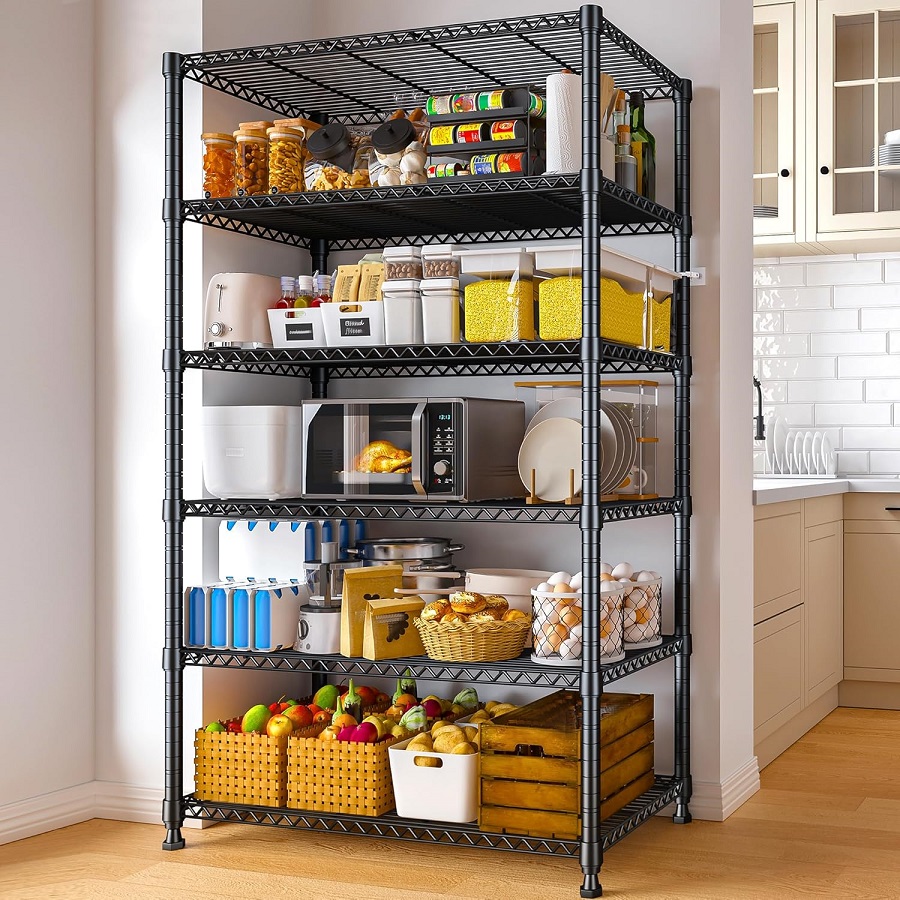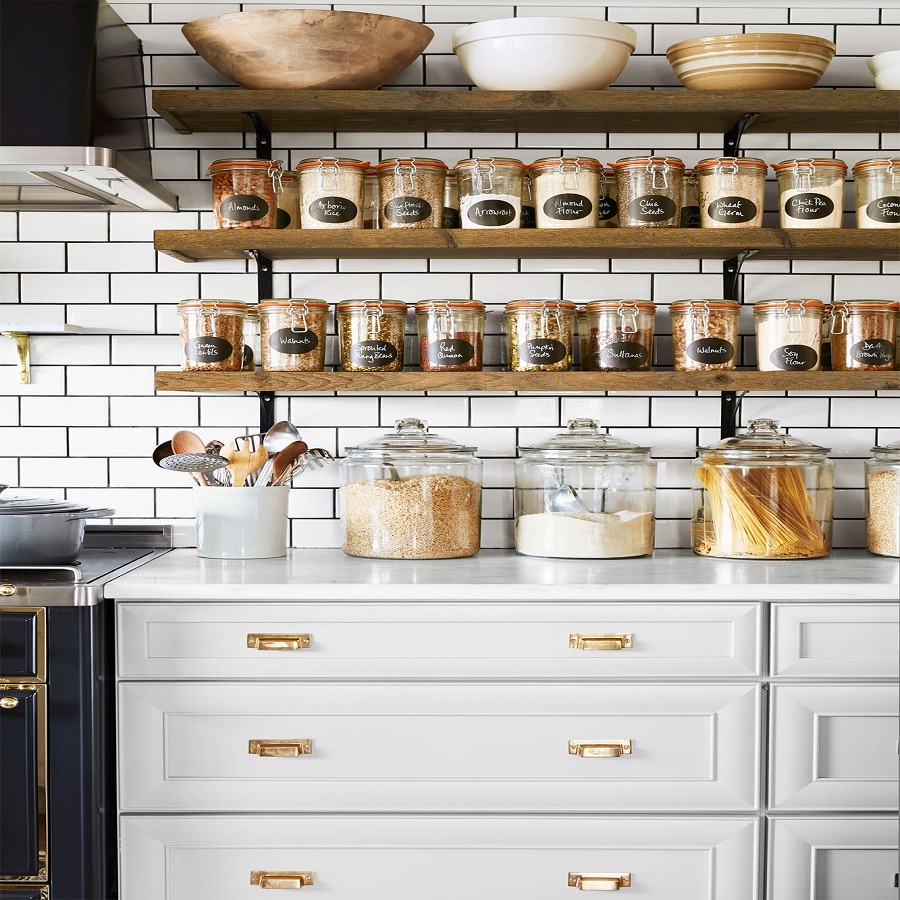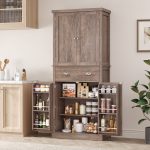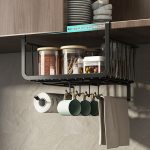Assessing Your Kitchen Storage Needs
Before you jump into buying storage shelves for your kitchen, take a step back to assess your needs. Start by evaluating how much storage space you currently have and how you’re using it. Are your counters cluttered? Do pots and pans spill out of cupboards? Or maybe your spices are scattered, making it hard to find what you need while cooking.
Take an inventory of your kitchen items. Group them into categories like cooking tools, appliances, dishware, and foodstuffs. This will give you a clear idea of what needs its own place. Think about the items you use daily versus those you use less often. Your storage solutions should make frequently used items easily accessible, while less-used items can be stored higher up or in less prime real estate.
Consider the flow of your kitchen too. Place items near where they will be used. For example, put pots and pans near the stove and cups near the kettle or refrigerator. This strategy can greatly enhance efficiency and reduce frustration during meal prep.
Lastly, don’t forget to take stock of the available wall space, corners, and underutilized areas. These areas often provide opportunities for adding storage shelves without compromising the floor space. By taking the time to thoroughly assess your kitchen’s storage needs, you’ll ensure that the shelving you choose truly enhances your kitchen’s efficiency and your overall cooking experience.
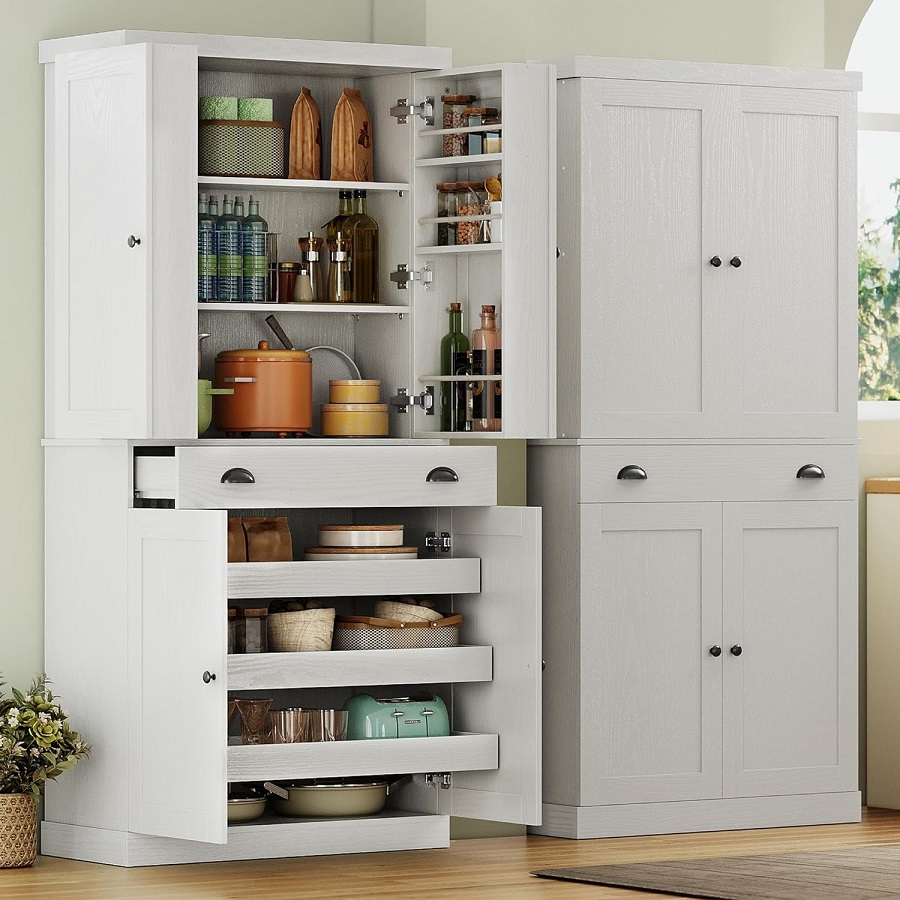 Choosing the Right Type of Shelving for Your Kitchen
Choosing the Right Type of Shelving for Your Kitchen
After assessing your storage needs, it’s time to choose the right shelves for your kitchen. It’s not just about looks; functionality is key. There are several types of shelving to consider, each with its own benefits.
- Fixed Bracket Shelves: These are the traditional type, mounted on the wall with visible brackets. They are sturdy and can hold a good amount of weight, making them ideal for heavy items like crockery.
- Floating Shelves: These have a sleek, modern look. They are perfect for displaying decorative items or storing things you need to access quickly.
- Adjustable Shelving: These shelves offer flexibility. You can move them to accommodate different-sized items as your needs change.
- Corner Shelves: Don’t overlook corners. Corner shelves maximize space that would otherwise go unused.
- Pull-out Shelves: These are excellent for lower cabinets. They slide out, giving you easy access to items at the back.
- Free-standing Shelves: If wall space is scarce, consider free-standing units. They can add storage and can be moved if necessary.
Incorporate the ‘storage shelves for kitchen’ where it makes sense, both functionally and stylistically. Measure your space and consider the weight of items you plan to store. Don’t forget to match the shelving material and style with your kitchen’s decor to create a cohesive look. Aim for a balance between practicality and aesthetic to ensure your kitchen remains a pleasurable place to work in.
Creative Shelving Solutions for Small Kitchens
When space is tight, creativity is key to ensuring your kitchen stays organized and functional. Small kitchens need smart storage shelves for kitchen efficiency without feeling cramped. Here are various solutions that cater to smaller spaces:
- Wall-Mounted Racks: Use the full height of your kitchen by installing wall-mounted racks. They can hold spices, utensils, or even pots and pans, keeping your counters clear.
- Magnetic Strips: Ideal for knives or metal tools, magnetic strips save drawer space and keep essential tools within arm’s reach.
- Under-Cabinet Hooks: Hang mugs or utensils beneath cabinets to free up shelf and counter space.
- Over-The-Sink Shelves: Utilize the space above your sink with a shelf for drying dishes or storing cleaning supplies.
- Stackable Baskets: Use vertical space in cabinets or on counters with stackable baskets that can organize fruits, vegetables, or snacks.
- Folding Furniture: Opt for a foldable table or chairs that can tuck away when not in use, conserving valuable floor space.
- Hanging Baskets: Suspend baskets from the ceiling to hold plants or frequently used items without using counter space.
By implementing these creative solutions, you can maximize the potential of your small kitchen. Always keep the items you use most within easy reach, and don’t be afraid to think outside the traditional cabinet box to find storage success.
Organization Tips for Kitchen Shelves
Organizing kitchen shelves boosts efficiency and reduces clutter. Follow these tips to streamline your storage shelves for kitchen spaces:
- Prioritize Accessibility: Place items you use most at arm’s reach. Store less frequently used items higher up.
- Categorize Your Items: Group similar items together. This makes it easy to find what you need without searching.
- Use Clear Containers: Transparent containers help you see contents at a glance. Label them for extra convenience.
- Declutter Regularly: Evaluate your kitchen items periodically. Remove things you no longer use to free up space.
- Utilize Shelf Liners: Shelf liners protect surfaces and prevent items from slipping. They also make cleanup easier.
- Employ Shelf Dividers: Dividers can separate stacks of dishes or organize pans. They help maintain neatness between different types of items.
- Implement a Rotation System: Rotate food items with upcoming expiration dates to the front. This reduces waste and helps manage pantry inventory.
Organized shelves make cooking and meal prep smoother. With everything in its place, you can focus on creating delicious meals in an uncluttered kitchen.
The Dos and Don’ts of Kitchen Shelf Styling
When it comes to styling storage shelves for kitchen use, it’s important to balance form and function. Here are some dos and don’ts to help you achieve a stylish yet practical kitchen shelf arrangement:
- Do Keep It Simple: Avoid clutter. A minimalistic approach lets your items shine and keeps your kitchen looking clean.
- Do Use Consistent Elements: Pick a theme or color scheme. Stick to it across shelving to create a cohesive look.
- Do Embrace Negative Space: Allow some empty space. It prevents shelves from feeling overcrowded and helps highlight your items.
- Don’t Sacrifice Function for Style: Ensure your everyday items are still within easy reach. Style should enhance, not hinder, kitchen workflow.
- Don’t Ignore Lighting: Good lighting can transform your shelves. It spotlights items and adds ambiance.
- Don’t Overlook Practicality: Items used daily should stay front and center. Keep less used items higher up or stored away.
By following these tips, your kitchen shelves won’t just store your items; they’ll display them in a way that’s both attractive and functional.
Maximizing Vertical Space with Storage Shelves
In a kitchen, every inch counts. Look up and use vertical space to your advantage. Storage shelves for kitchen can transform unused wall areas into valuable storage. Here are ways to elevate your kitchen’s organization with vertical storage shelves:
- Install Tiered Shelving: By stacking shelves above each other, you create multiple levels of storage. Use these for items you need but don’t use daily.
- Use Tall Units: A tall shelving unit takes up minimal floor space and provides plenty of vertical storage options.
- Add Hooks Under Shelves: Hooks can hang mugs, utensils, or towels, keeping these items handy without using shelf space.
- Utilize the Space Above Appliances: The space above the fridge or oven can hold storage shelves for seldom-used items.
- Incorporate Over-Door Racks: The back of the kitchen door can support a rack for extra storage, perfect for spices or small jars.
By using these methods, you’ll create more room to move and work in your kitchen. Vertical storage also makes it easier to see and grab items when you’re in the middle of cooking. Remember to place heavier items lower and lighter items higher for safety and ease of use.
Maintaining and Cleaning Your Kitchen Shelves
Maintaining your storage shelves for kitchen is essential for lasting function and beauty. First, make a habit of wiping down shelves weekly. Use a gentle cleaner and a soft cloth. This prevents dust and grime buildup. Avoid harsh chemicals which can damage shelf surfaces. Instead, use a mix of warm water and mild dish soap.
Organize your items before cleaning. Remove everything from the shelves. This lets you reach all areas without obstruction. As you clear shelves, check items for expiry dates or signs of wear. It’s a good chance to declutter.
For wooden shelves, use a wood-friendly cleaner. Apply a small amount and follow the grain when wiping. Dry the shelves completely to prevent warping or mold.
For metal or wire shelves, use a damp cloth. Follow with dry wiping to prevent rust. If your shelves have detachable parts, take them apart to clean nooks and crannies.
Slide-out shelves need care as well. Ensure the sliding mechanism is clean and operates smoothly. Sometimes, a bit of lubricant helps if they stick.
Lastly, handle fragile items with care. Put dishes and glassware back gently to avoid chips or cracks. Regular maintenance keeps your kitchen organized and your shelves in top shape.
The Best Materials for Durable Kitchen Shelving
When selecting storage shelves for kitchen use, durability is a top concern. The right materials can ensure your shelves withstand daily use and continue to look great over time. Here are the best materials for kitchen shelving that combine both strength and style:
- Metal Shelves: Metal is a strong material that can handle heavy items. Stainless steel options are resistant to rust and provide a modern look.
- Wood Shelves: Solid wood shelves offer a classic appeal and can bear substantial weight. Choose hardwoods like oak or maple for long-lasting use.
- Engineered Wood: Particleboard or MDF is affordable and comes in a variety of finishes. They’re ideal for those who want a stylish, cost-effective solution.
- Glass Shelves: Glass adds an elegant touch and is suitable for lighter items. Ensure the glass is tempered for added durability.
- Plastic Shelves: For areas prone to moisture, like under the sink, plastic shelving is practical. It won’t warp or mold.
- Wire Shelves: These allow air circulation, making them perfect for storing fresh produce or dish towels.
Remember, the material you choose should match your kitchen’s needs and aesthetic. Consider the load capacity and maintenance requirements of each material. With proper care, your durable kitchen shelves will continue to serve you for years to come.
